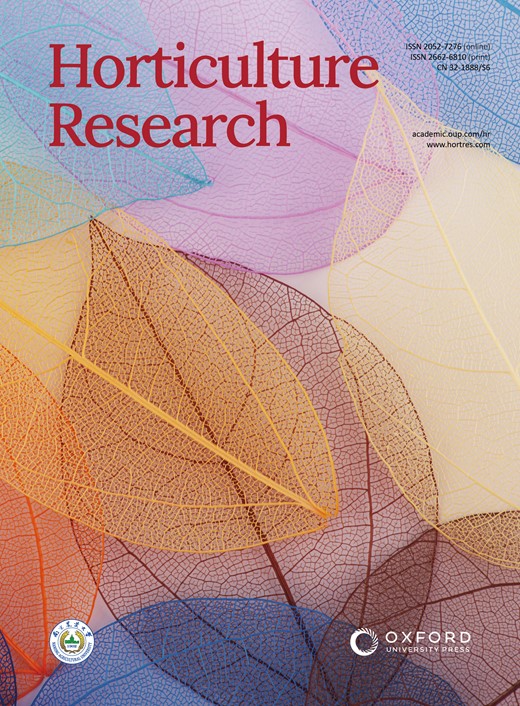甜樱桃(Prunus avium L.)糖和酸含量的遗传和 QTL 分析
IF 8.7
1区 农林科学
Q1 Agricultural and Biological Sciences
引用次数: 0
摘要
甜樱桃因其诱人的外观和酸甜均衡的口感深受消费者喜爱。在这项工作中,研究了甜樱桃可溶性固形物含量(SSC)、可滴定酸度(TA)、糖和有机酸的遗传学,以促进果实品质的育种改良。对五个甜樱桃种群(N = 372)(三个 F1 和两个 F2)的果实进行了为期两年的采样,通过超高效液相色谱法(UPLC)评估了 SSC、TA 以及各种糖类(葡萄糖、果糖、山梨醇和蔗糖)和有机酸(苹果酸、奎宁酸、草酸、柠檬酸和莽草酸)的含量。葡萄糖是含量最高的糖类,其次是果糖,而苹果酸是最主要的酸类。山梨醇和苹果酸是不同年份之间最稳定的化合物,而且遗传率最高,分别与 SSC 和 TA 的相关性最好,这表明它们对育种具有重要意义。糖类与 SSC、酸类与 TA 之间存在显著的正相关,但所有性状的年际变异性都很高。使用 FlexQTL™ 的多家族方法对 SSC、糖、TA 和有机酸进行了 QTL 绘图。在两个表型年中持续检测到 20 个 QTL,还发现了几个与糖和酸的 QTL 重叠的相关区域。结果证实,主要稳定的 SSC 和 TA QTL 分别位于第 4 和第 6 连接组。在主要的 LG4 SSC QTL 区域内(之前已在该区域检测到成熟度和果实发育时间 QTL),还发现了三个稳定的糖(葡萄糖、山梨醇和蔗糖)和两个酸(奎宁酸、莽草酸)QTL,这表明成熟期对这些化合物的含量具有多效应。主要的苹果酸 QTL 与 LG6 上的 TA QTL 重叠,因此 LG6 上的 TA QTL 映射可能对应于苹果酸 QTL。对 LG4 上的主要 SSC 和糖 QTL 以及 LG6 上的 TA 和苹果酸 QTL 进行单倍型分析,发现了具有育种意义的单倍型。之前在桃等其他李属水果物种中发现的几个候选基因与本文检测到的 QTLs 位于同一位置。这项研究首次报道了梅属非climacteric核果中糖和酸含量的 QTLs 区域和单倍型。本文章由计算机程序翻译,如有差异,请以英文原文为准。
Genetic and QTL analysis of sugars and acids content in sweet cherry (Prunus avium L.)
Sweet cherry is very appreciated by consumers because of its attractive appearance and taste, which is determined by the balanced sweet-sour flavor. In this work, the genetics of soluble solid content (SSC), titratable acidity (TA), sugars and organic acids was investigated in sweet cherry to facilitate breeding improvement for fruit quality. The fruits of five sweet cherry populations (N = 372), three F1 and two F2, were sampled over two years to evaluate SSC, TA, and the content of individual sugars (glucose, fructose, sorbitol, and sucrose) and organic acids (malic, quinic, oxalic, citric and shikimic) by ultra-performance liquid chromatography (UPLC). Glucose, followed by fructose, was the most abundant sugar, while malic acid was the predominant acid. Sorbitol and malic acid were the most stable compounds between years, and had the highest heritability, being also the best correlated to SSC and TA respectively, revealing their relevance for breeding. Significantly positive correlations were observed among sugars and SSC, and acids and TA, but high interannual variability between years was observed for all traits. QTL mapping for SSC, sugars, TA, and organic acids was performed using a multi-family approach with FlexQTL™. Twenty QTLs were detected consistently during the two phenotyped years, and several relevant regions with overlapping QTLs for sugars and acids were also identified. The results confirmed major stable SSC and TA QTLs on the linkage groups 4 and 6, respectively. Within the main LG4 SSC QTL region, where maturity and fruit development time QTLs have been previously detected, three stable sugar (glucose, sorbitol, and sucrose) and two acid (quinic, shikimic) QTLs were also identified, suggesting a pleiotropic effect of ripening date on the content of these compounds. The major malic acid QTL overlapped with TA QTL on LG6, thus TA QTL mapping in LG6 may correspond to malic acid QTLs. Haplotype analyses of major SSC and sugars QTL in LG4, and TA and malic acid in LG6 revealed haplotypes of breeding interest. Several candidate genes previously identified in other Prunus fruit species, like peach, were found to collocate with the QTLs detected herein. This work reports QTLs regions and haplotypes of sugar and acid content in a Prunus non-climacteric stone fruit for the first time.
求助全文
通过发布文献求助,成功后即可免费获取论文全文。
去求助
来源期刊

Horticulture Research
Biochemistry, Genetics and Molecular Biology-Biochemistry
CiteScore
11.20
自引率
6.90%
发文量
367
审稿时长
20 weeks
期刊介绍:
Horticulture Research, an open access journal affiliated with Nanjing Agricultural University, has achieved the prestigious ranking of number one in the Horticulture category of the Journal Citation Reports ™ from Clarivate, 2022. As a leading publication in the field, the journal is dedicated to disseminating original research articles, comprehensive reviews, insightful perspectives, thought-provoking comments, and valuable correspondence articles and letters to the editor. Its scope encompasses all vital aspects of horticultural plants and disciplines, such as biotechnology, breeding, cellular and molecular biology, evolution, genetics, inter-species interactions, physiology, and the origination and domestication of crops.
 求助内容:
求助内容: 应助结果提醒方式:
应助结果提醒方式:


